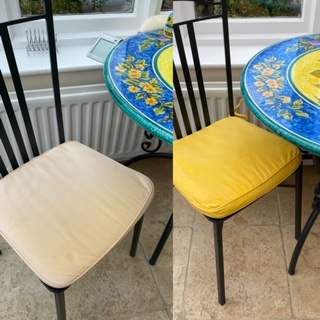Natural Dyeing
Dyeing fabrics using natural dye works very well particularly on natural fabrics. Manmade fabrics can produce blotchy results – absolutely fine for tie dying projects but I wanted an even, all over colour. This project involved 4 cotton/linen chair pad overs very badly faded and stained in parts. They were really ready for replacing but I couldn’t find the right colour, dimension or simple style. Instead, I thought I would dye them myself. Tip: Work outside then if there are any spills the cleaning up is without stress. Wear rubber gloves and use old pans, spoons, bowls and utensils.
Preparation
Start by washing the item(s) you are wanting to dye. Use a 60 degree cycle wash with no detergent and no fabric conditioner. Use 2 tbsp washing soda (sodium carbonate)in the detergent compartment or directly into the drum.
Once washed and whilst still wet place the item(s) in a roomy saucepan or preserving pan and use sufficient of the preparation mix (ie 4 parts water to 1 part vinegar) to cover the items. For my four chair pads I needed 500ml (1 pint vinegar) and 2 litres (4 pints) water.
Bring the pan and the item(s) to the boil and leave to simmer for one hour. This preparation will ensure the fabric absorbs the dye.
Whilst the pan of vinegar, chair pad covers and water were bubbling away I prepared the dye. The colour I wanted to get back to was the original yellow – a mix between the bright yellow of mustard and the warm orange yellow of turmeric. I decided that is exactly what I would do. 1 tbsp of mustard and 1 tbsp turmeric to one pint of water.
Deciding to dye a single item will not require a huge volume of dye but I had four large chair pad covers and my dye bath used 14 pints of water and 14 tbsp mustard powder and 14 tbsp turmeric plus 3 tbsp Alum (mordant).
A note re mordanting : Mordanting using the Alum crystals ensures the dye fixes to the fabric. Alum is essential otherwise your dye will fade, the dye will not bond to the fabric fibres and the finish will be streaky and uneven.
Use an aluminium pan or old saucepan because the dye will stain and remember to wear rubber gloves. Measure the mustard, turmeric and Alum into the pan, add the water and stir well.
Put the pan of dye onto the heat and bring to a boil and simmer for 20 minutes then turn off the heat.
Once the fabric has boiled in the water/vinegar solution for an hour, remove using tongs and leave to drain. Once cool enough to handle with gloved hands squeeze out excess moisture.
If you are wanting to dye more than one item and you want the same even colour in each one then the same strength of dye bath is required. I separated my dye into four parts to ensure even finished colour on each of the four chair covers.
Place the item to be dyed into the dye bath, bring to the boil and simmer for 20-30 minutes depending on the strength of the colour you want. Stir the dye regularly and make sure the fabric is submerged.
At the end of the time transfer the item into the hot salt bath, swirling around then transfer to a bucket of cold water and rinse until the water runs clear.
Leave to drip dry outside away from direct sunlight.
Once dry the chair covers were pressed and replaced and I am very pleased.
< Back to Recipes










